Living room wall decor ideas – 27 easy ways to add style
Make your living room walls the focal point with stylish ideas and decorative tricks that will add instant wow

When it comes to living room wall decor, playing safe isn’t the only option. While calm neutrals and soft colours have their place, the best living room wall decor ideas bring colour and personality too.
‘Paint is the perfect way to transform a space quickly and easily, adding personality and character to create an inspired interior,’ says Ruth Mottershead, Creative Director at Little Greene. ‘Add impact to your living space with bands of colour painted as horizontal stripes or use blocks of colour to create a focal point such as the backdrop to a favourite artwork, or perhaps highlight architectural detailing.'
‘Add a sense of adventure to your living room and get creative with colour. Think of paint as an expression of the family who live within its walls,’ adds Ruth.
Living room wall decor ideas
While paint and wallpaper are the most obvious choice for easy and inexpensive living room ideas, there are lots of other creative treatments and clever tricks that can be put together to give living room walls an extra dimension.
Wall art is a super-simple way of livening up too-plain living room wall decor, whether a structured gallery wall or an informal mix of family photographs on simple picture ledges. Or think outside the box, with creative storage, rustic panelling or a wall of greenery, for easy alternative options that won’t cost a fortune.
1. Play with mirrors and shapes
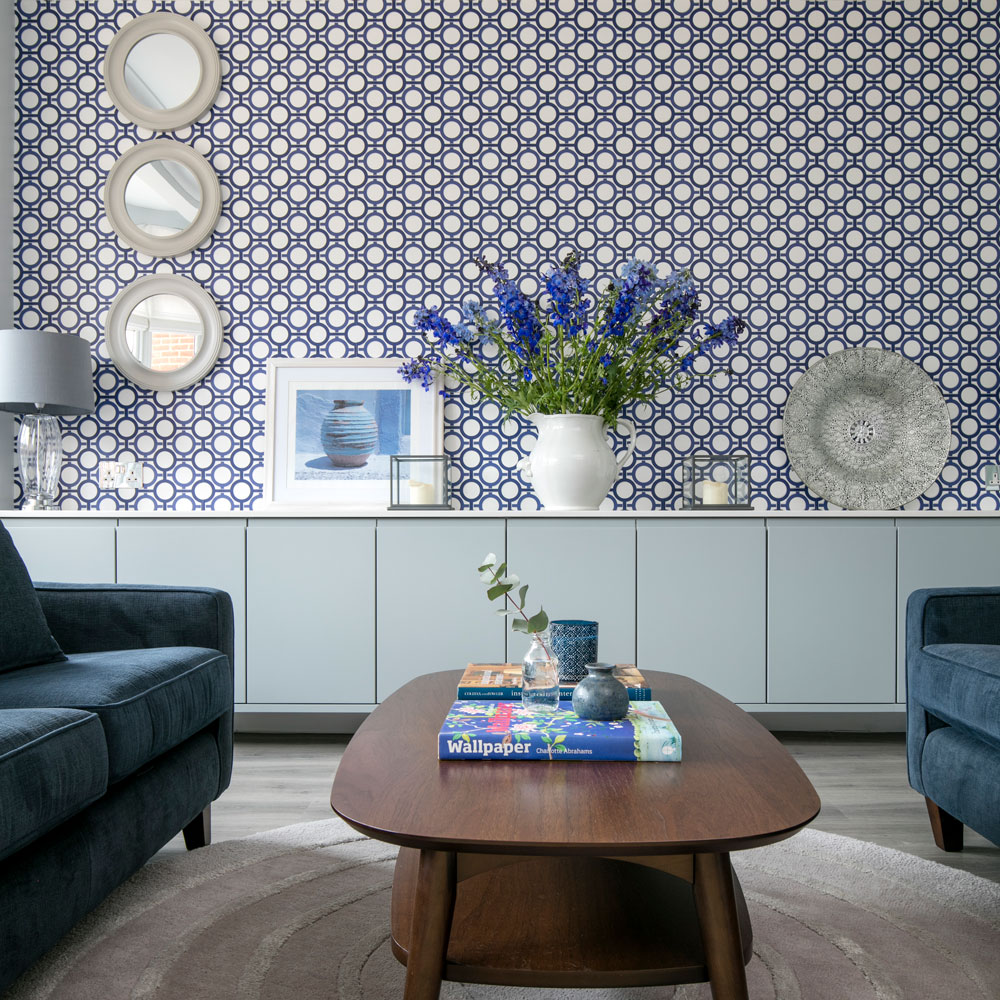
‘Try clustering mirrors together,' says Bethan Harwood, Partner & Home Design Stylist at John Lewis, 'placing opposite a brighter space or window. They can be really effective in making the room seem more open. Decorating the background wall depends on how heavy the frames are – quirky and antique, then go subtle, while clean or metallic edges can be balanced with a deep colour for more of a hotel look.’
If your wallpaper features a graphic print , like the circular repeat pattern above, echo the shape with similarly shaped mirrors and colour coordinated furniture and accessories.
Get the Ideal Home Newsletter
Sign up to our newsletter for style and decor inspiration, house makeovers, project advice and more.
2. Try a feature wall wallpaper
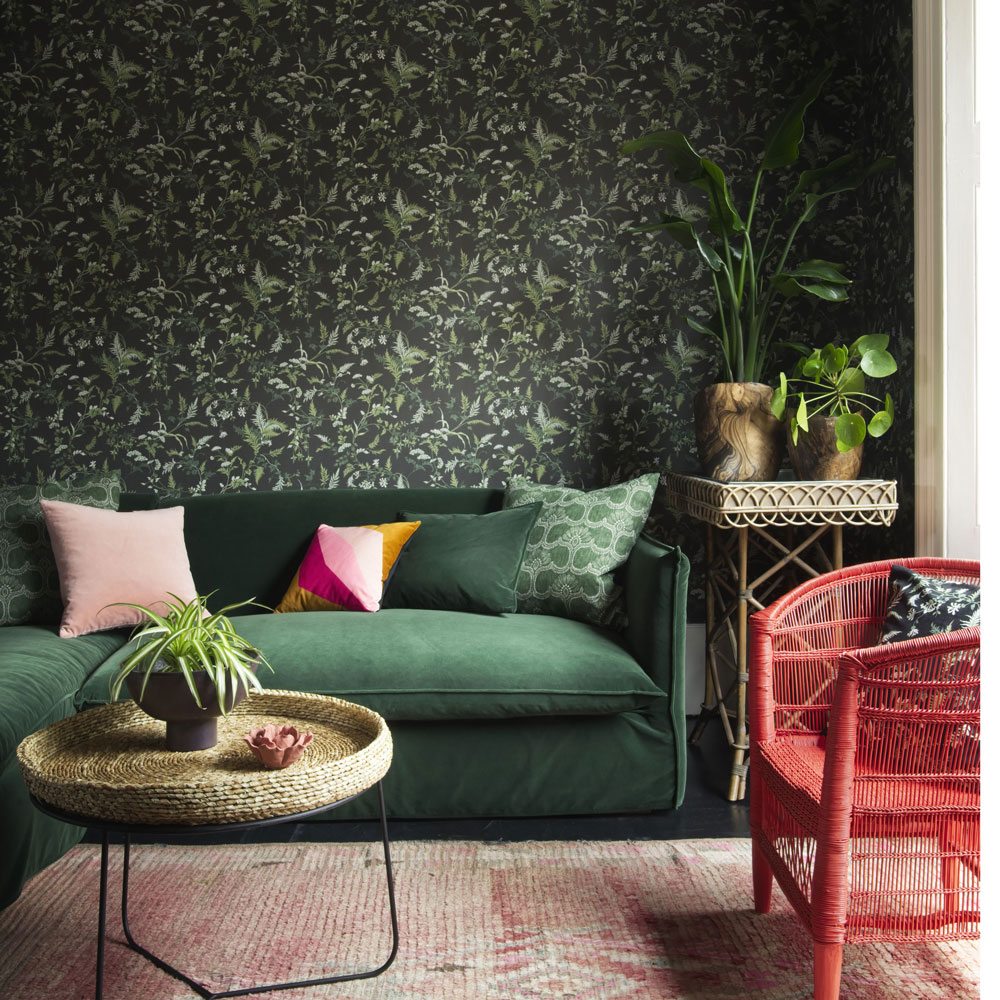
‘Feature walls are quite controversial,' explains Bethan Harwood at John Lewis, 'as balance is key to a room that is comfortable to live in – and that includes colour and pattern. If you have a loud patterned wallpaper, then draw those colours out into your soft furnishings to bridge the visual gap.'
'Consider the feeling you want to create in your living room,' suggests Bethan. 'If it’s a calm and relaxed space, then opt for panelling for a subtle new dimension, while if it’s a family room where children play, add a vibrant wallpaper to match the everyday chaos.’
3. Add lashings of drama with brightly painted panels
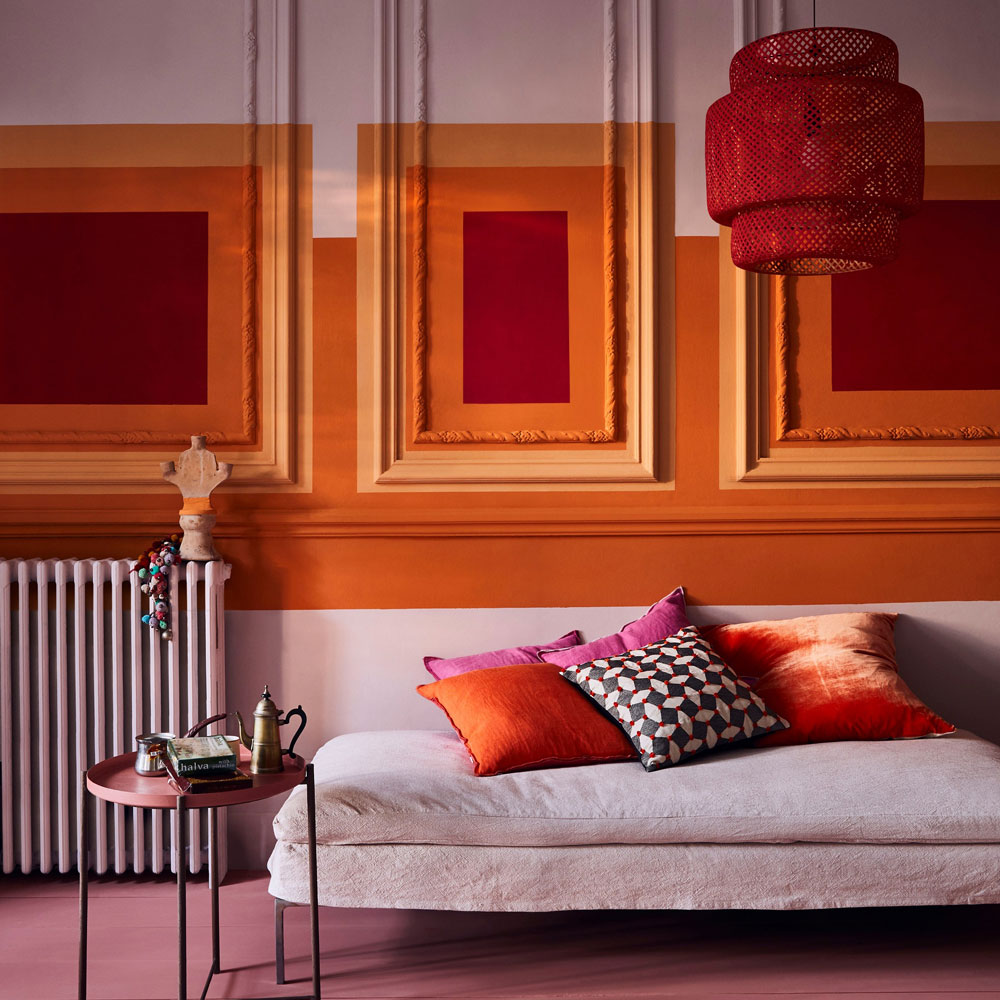
Another easy way to style and draw focus is to add bold colour to panelling to make a dramatic feature wall. ‘A feature wall gives the eye a starting focal point before the eye moves on and takes in the rest of the room,' explains Lisa Honiball, owner of Honey Interior Design. Bethan Harwood, Partner & Home Design Stylist at John Lewis agrees: ‘You should notice a feature wall as soon as you walk in - it should make an instant impact.’
4. Keep it natural with vertical timber panelling
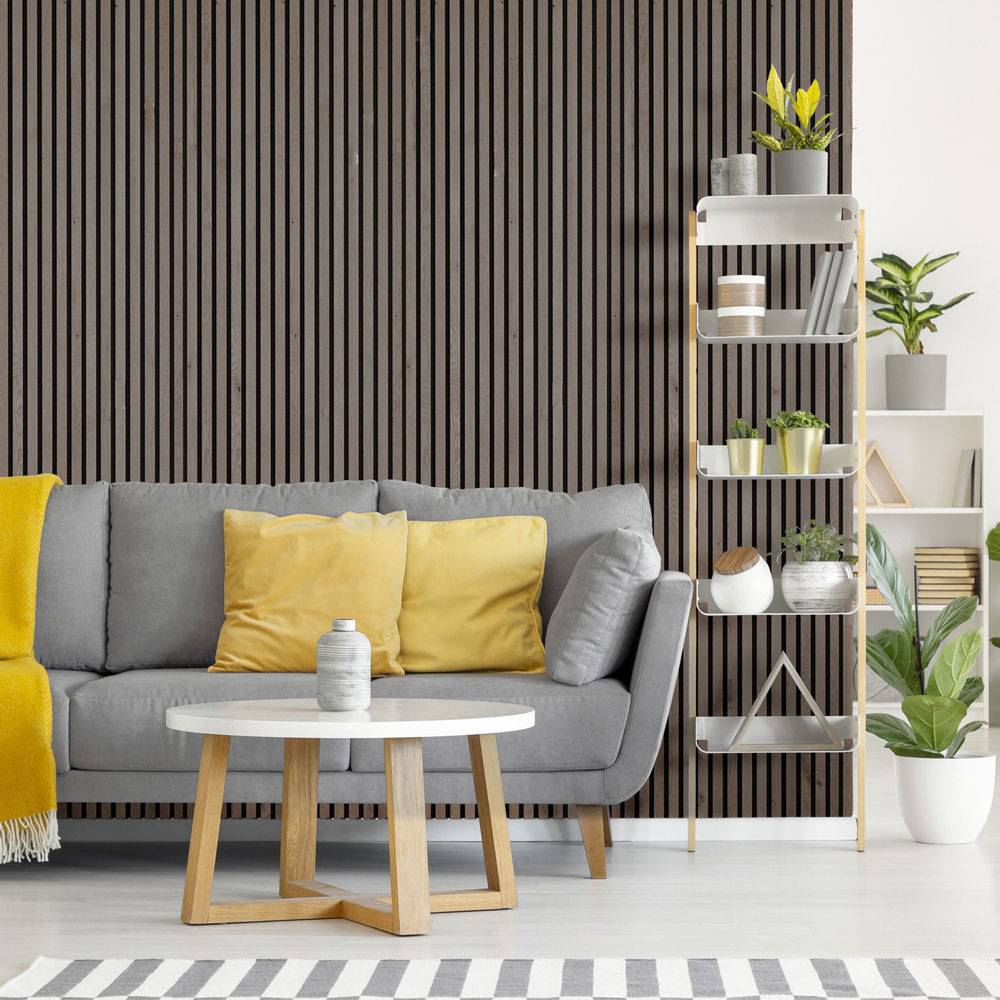
Low ceilings? Lacking style? Wall panelling ideas are a great place to start and adding sections of vertical panelling to a room will solve both issues by drawing the eye upwards thanks to the repetitive lines. It also adds instant elegance to a space, too.
Panelling likes this is easy to install as it comes in wide sections that you just secure to the wall. Smart and contemporary, panelling like this also has the bonus of adding a layer of soundproofing to the space, too.
5. Make wallpaper your hero and don't hide it
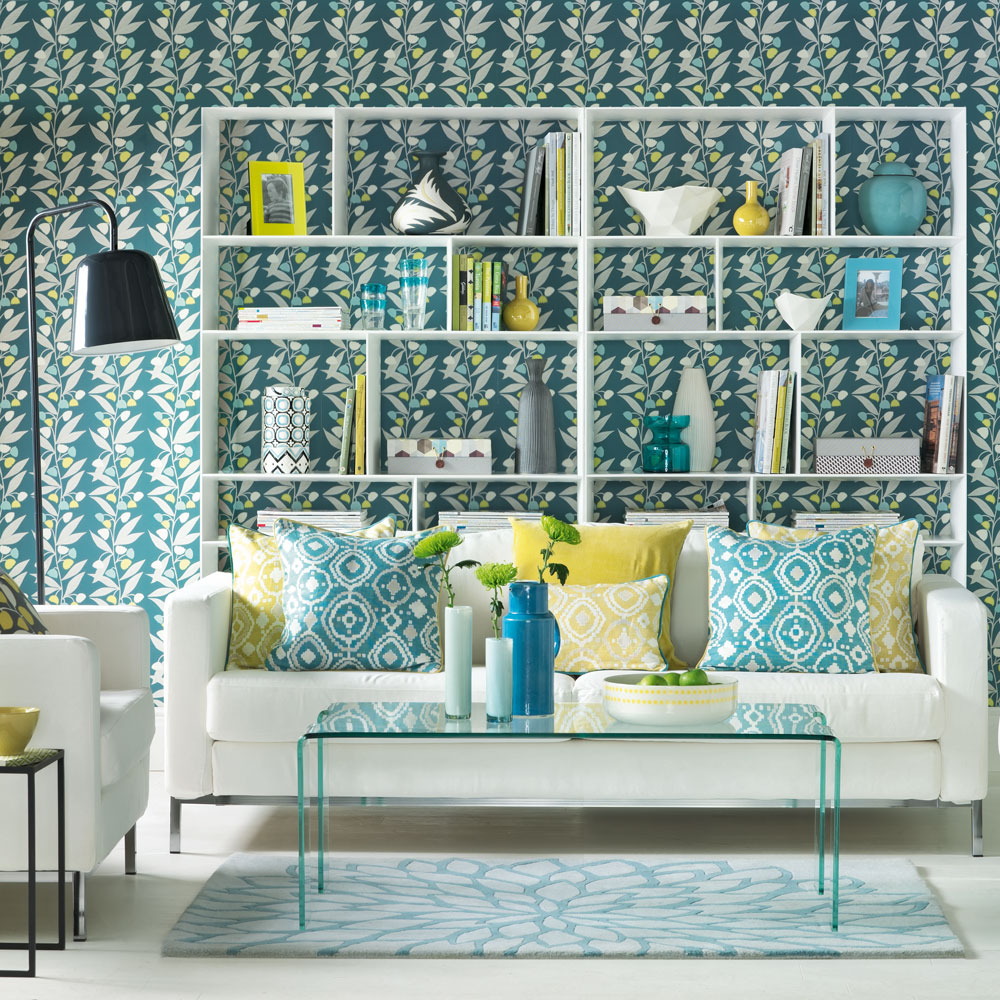
Keep your furniture and accessories and make a wallpaper the hero of your scheme. ‘Pick a wall that won’t be covered by too much furniture or doesn’t have too many windows,' suggests Crown Colour Consultant, Justyna Korczynska, 'as it would make the feature disrupted and overpowered.’
Open-backed shelving against a wallpapered wall gives a living room much needed storage while still allowing the pattern to shine through. The trick is not to overfill or add too much clutter to the shelving.. 'Alcoves and shelving can also make a feature, especially if every item displayed tells a story,' says Bethan Harwood, Partner & Home Design Stylist at John Lewis.
6. Stick with a subtle look that plays with shape and shadow
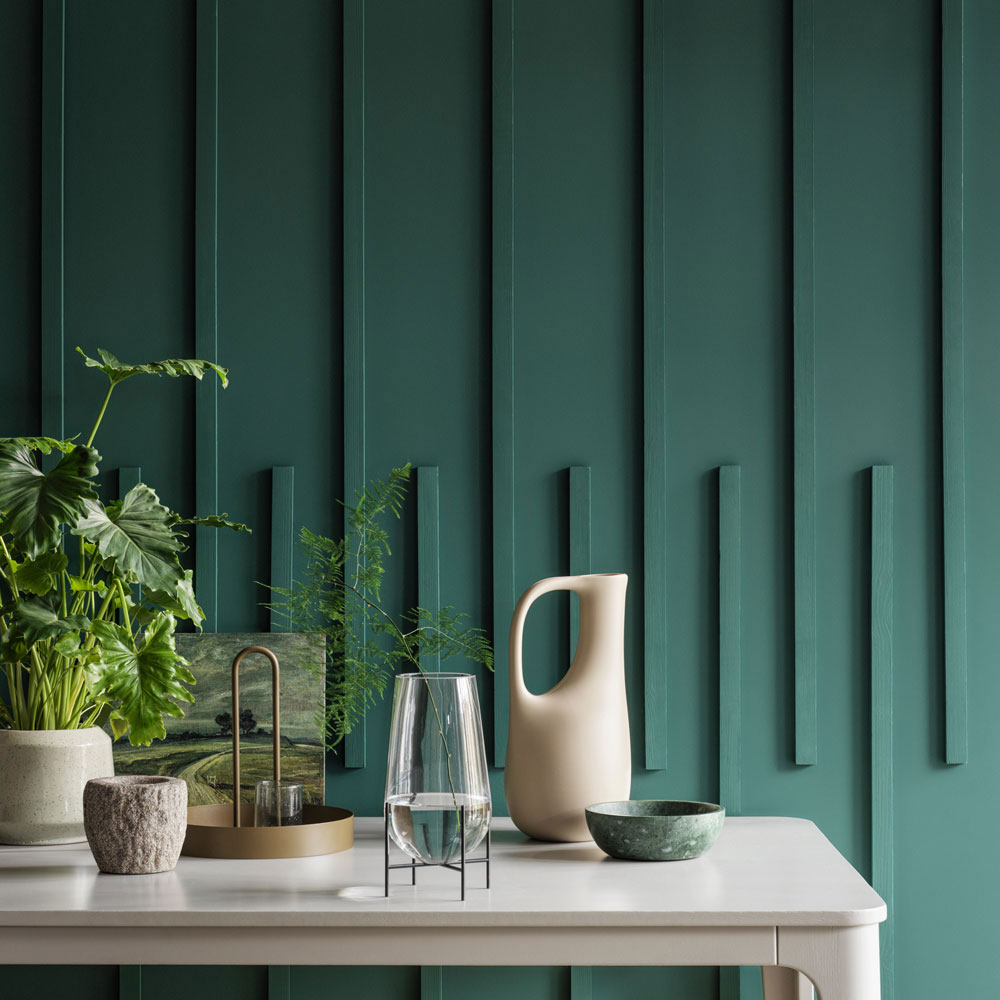
Not one for dramatic looks? Keep it simple with paint and the addition of subtle additions. Beading added to the wall and painted in the same shade as its background allows the natural light to fall in the shapes and create delicate shadows on the wall.
Justyna Korczynska, Crown Colour Consultant agrees. 'If you’ve architectural elements, work with them to create a feature, or think about panelling – the highlights and shadows created add another level to a painted living room feature wall.’
7. Stamp your space with fabulous femininity
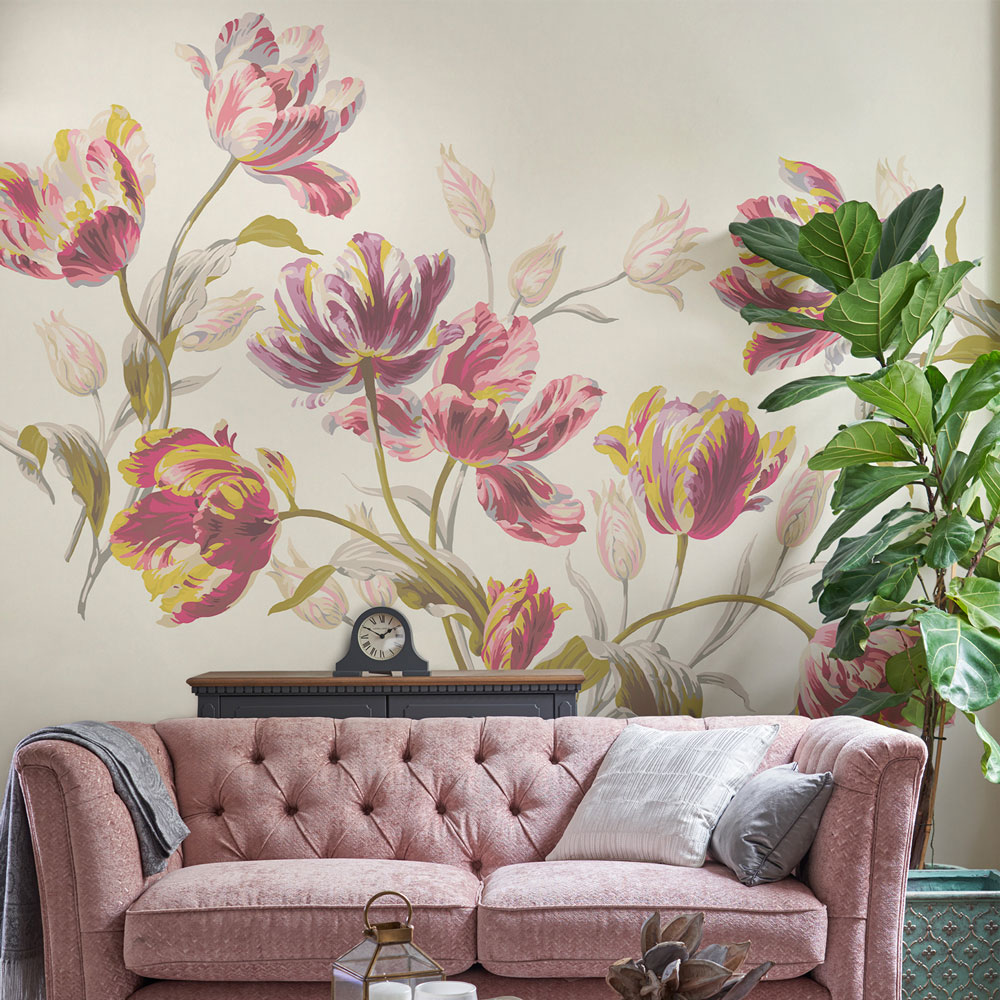
Murals are a big step for the decorating shy but they're perfect for breaking up large expanses of wall. Want to add warmth to a cold space? Soft feminine shades and soft shapes will create a far more cosy feel and the addition of a wall mural in a big, blowsy floral print will anchor the warm furniture and accessories. Don't shy away from introducing real plants and flowers to echo the look.
8. Go for continuous colour to cosy things up
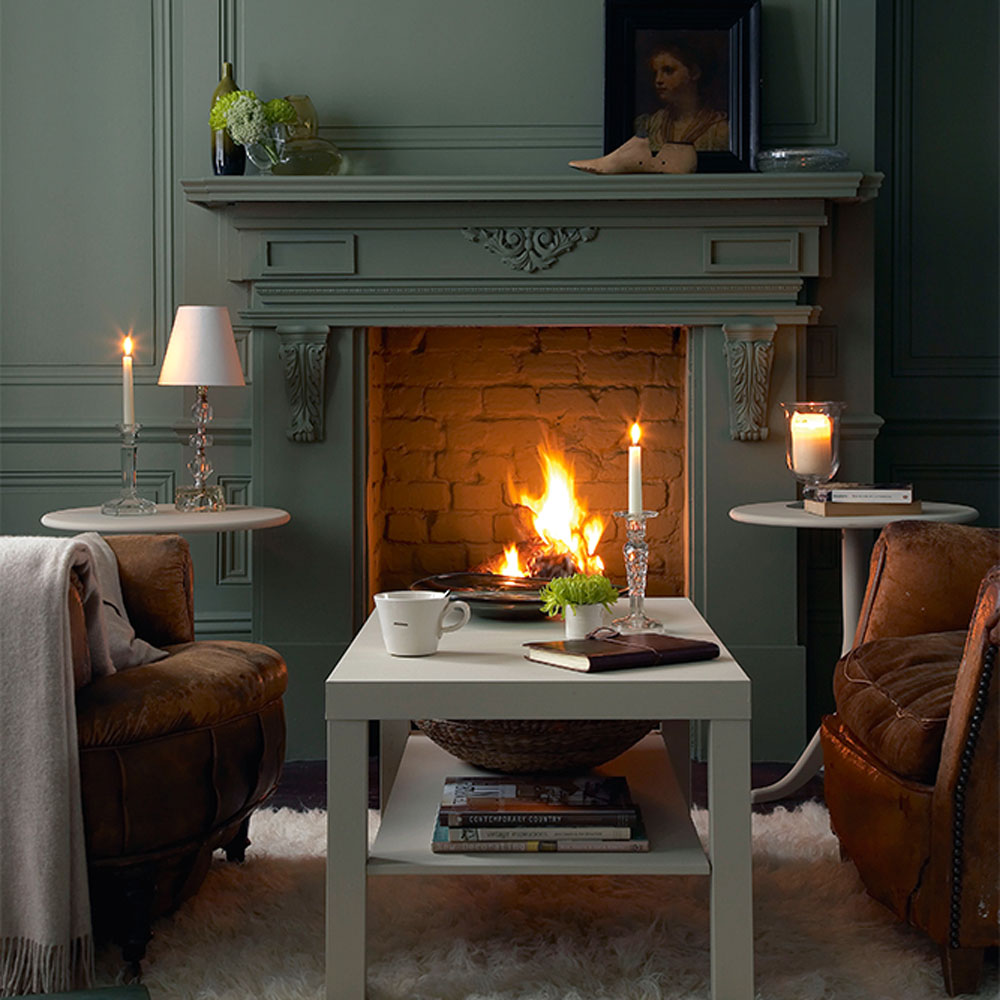
Create a calm and cosy living room scheme by painting walls and woodwork to match in a dark, dusky shade. Warmer tones feel enveloping and rich and are ideal for living spaces where we want to relax and cocoon ourselves away.
While more traditional to paint skirtings and woodwork in standard white, this creates a harsh break that jars the eye visually, while continuous colour helps blur the lines and will also save cutting-in time when painting.
‘Painting walls and woodwork in the same colour, or slight tonal variations of the same hue, creates a monochromatic scheme that seamlessly stretches the look of the walls from the floor and ceiling,’ says Ruth Mottershead, Creative Director at Little Greene.
‘Continue the same colour across doors, door frames and cornices to further create an uninterrupted feel to a room. Our Colour Scales collection offers 48 sophisticated neutrals, each organised into 12 families, making it easy to achieve a harmonious look when combined.’
9. Try a half-and-half paint treatment
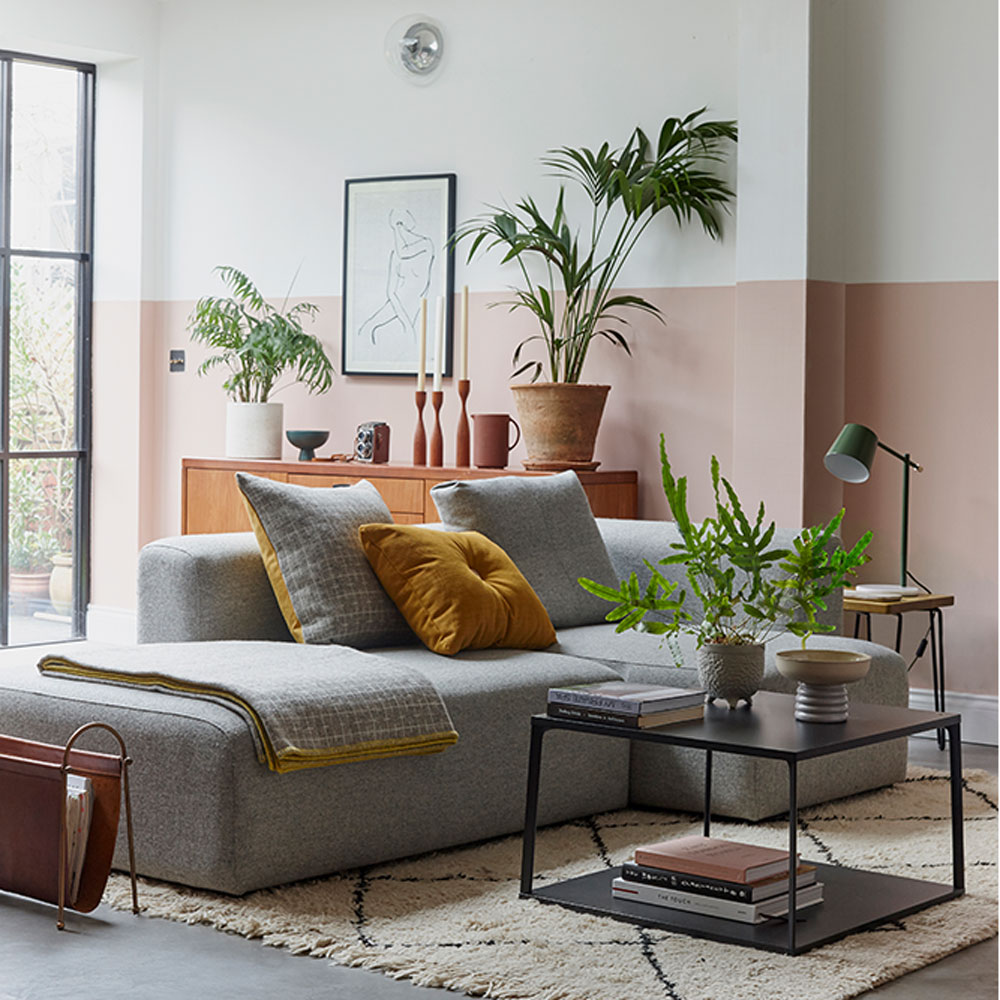
Break up an all-white living room wall decor by introducing a band of warmer colour to run throughout the space. Wrapping the room halfway with a swathe of soft plaster pink will lift harsh white walls and create a more colourful backdrop for showing off furniture and art work.
Paint from the skirting boards up to the middle of the wall and finish with a crisp, straight edge. For a bolder look, choose a darker shade for the bottom colour, but keep the top half of the wall bright white, as well as the ceiling too.
10. Spice up living room walls with wallpaper
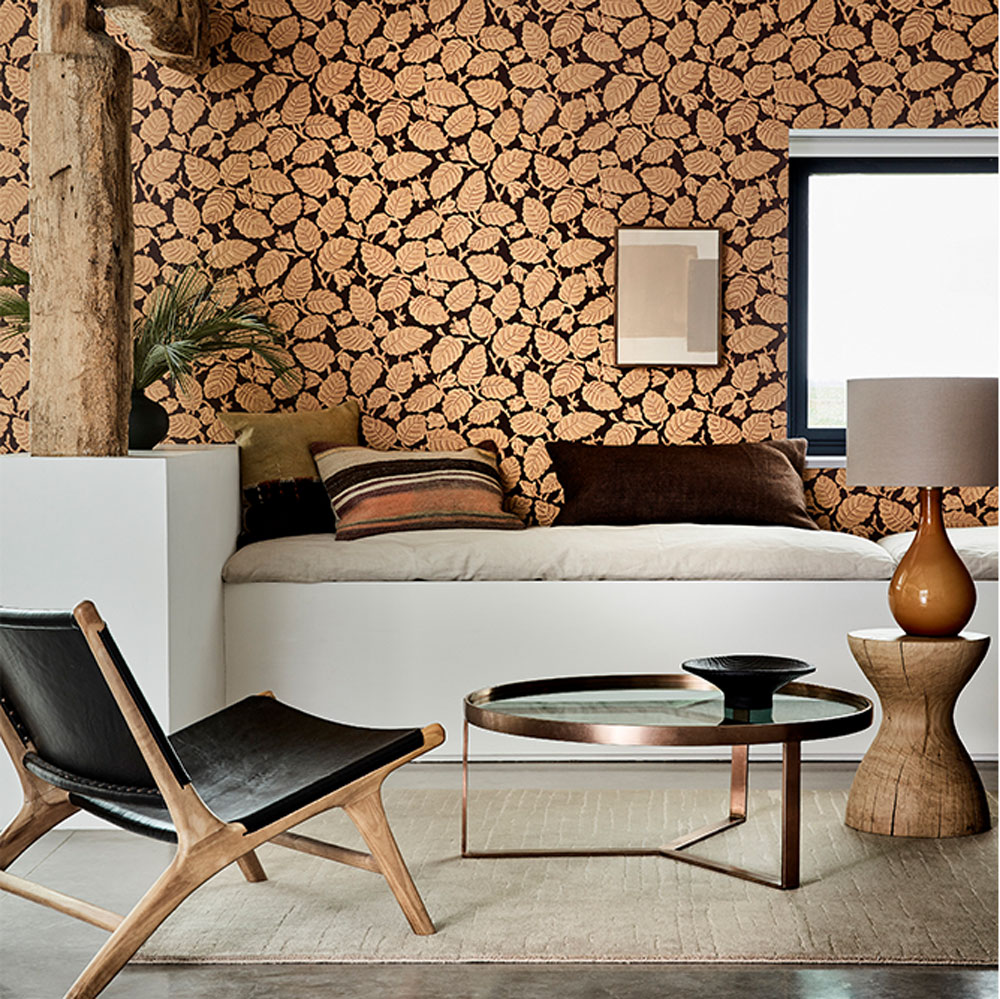
Give your living room a touch of cabin chic, with a standout wallpaper in a rustic, leafy print. Earthy colours, woody tones and touchable textures like this will give plain rooms extra depth and warmth.
Try wallpapering just one wall, behind a built-in seating area or as a backdrop to your sofa. Living room feature wall ideas are one of the easiest ways of transforming a lacklustre space and will only require a roll or two of wallpaper, so are more cost-effective than wallpapering the entire space.
11. Dare to go dark and dramatic
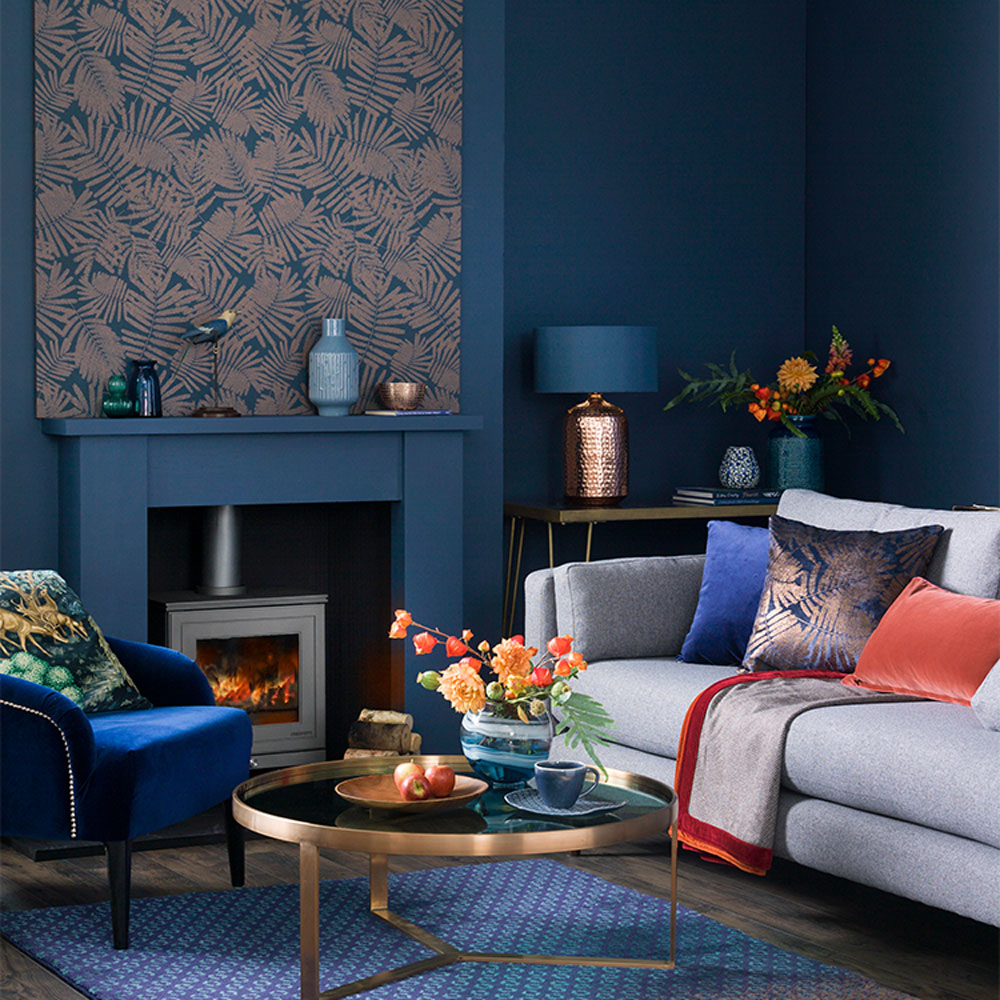
Don’t shy away from using darker paint colours in a small living room. Dark colours on walls can create a receding effect so that walls seem further away, visually enlarging the space.
Dark living room walls also make a great foil for rich colours, plush textures and metallic finishes, so bring in lots of sparkle and shine on accent furniture, soft furnishings and wall art. Make your own art with a length or two of metallic wallpaper on a large panel, an easy way of introducing a touch of pattern without a full-on look.
‘Dark colours might instinctively be colours to avoid if you are looking to create a feeling of space, as people fear making their room look smaller,’ says Ruth. ‘But, conversely, very rich blues, dark greys and fathomless greens have an almost bottomless depth that our eyes find hard to focus on – and thus create a sense of a wall being further away than it actually is. This works especially well on walls at the far end of rectangular living spaces.’
12. Create a living room gallery wall
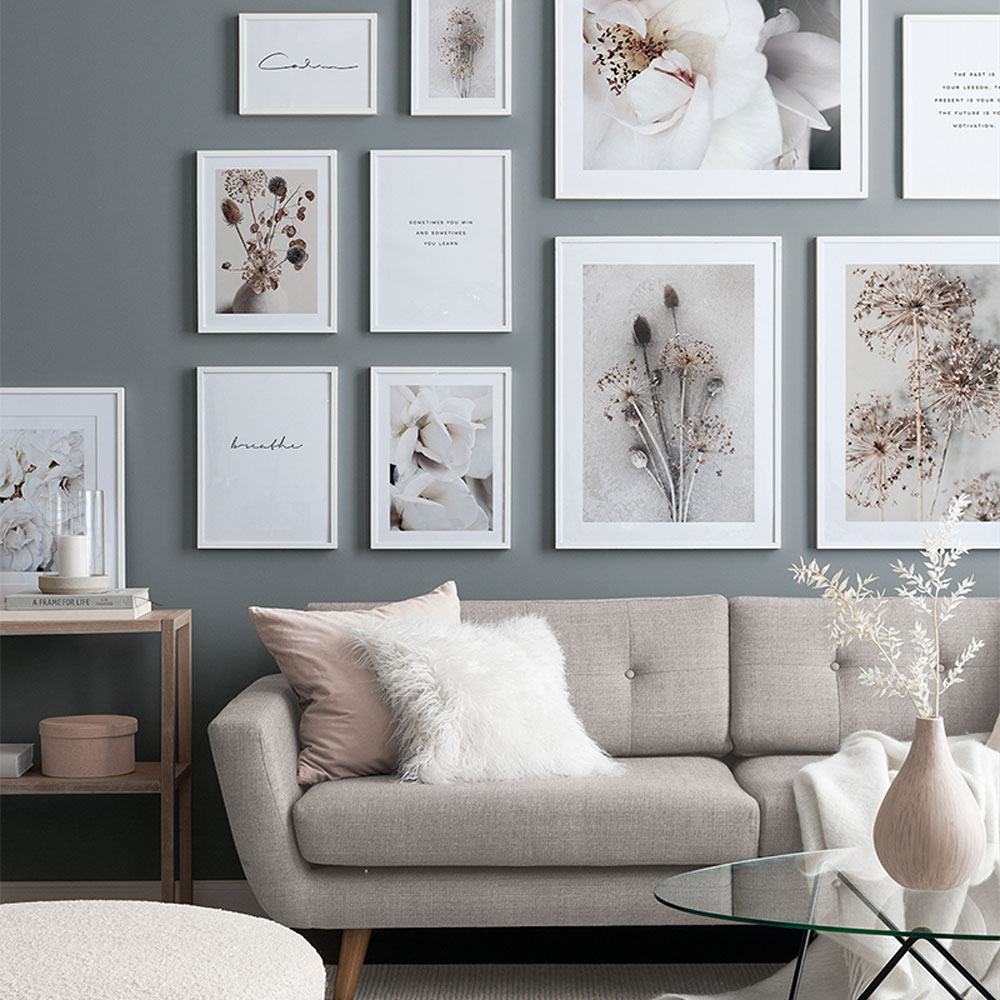
Putting up pictures or family photographs is one of the easiest ways of adding personality to empty walls and makes a fabulous focal point for a living room. Any wall will do, but decorating the wall behind the sofa is an ideal way of filling a large expanse of space.
‘A grid arrangement is a great choice if you like keeping things clean and organised,’ say the design team at Desenio. ‘The grid style of a gallery wall allows you to mix and match many different art posters and photo prints while still achieving a clean look.’
‘If you want to keep your wall art streamlined, stick to two or three colours when choosing the art prints. Or maybe go for black-and-white prints all the way, the choice is yours.'
13. Go bold with playful shapes and colours
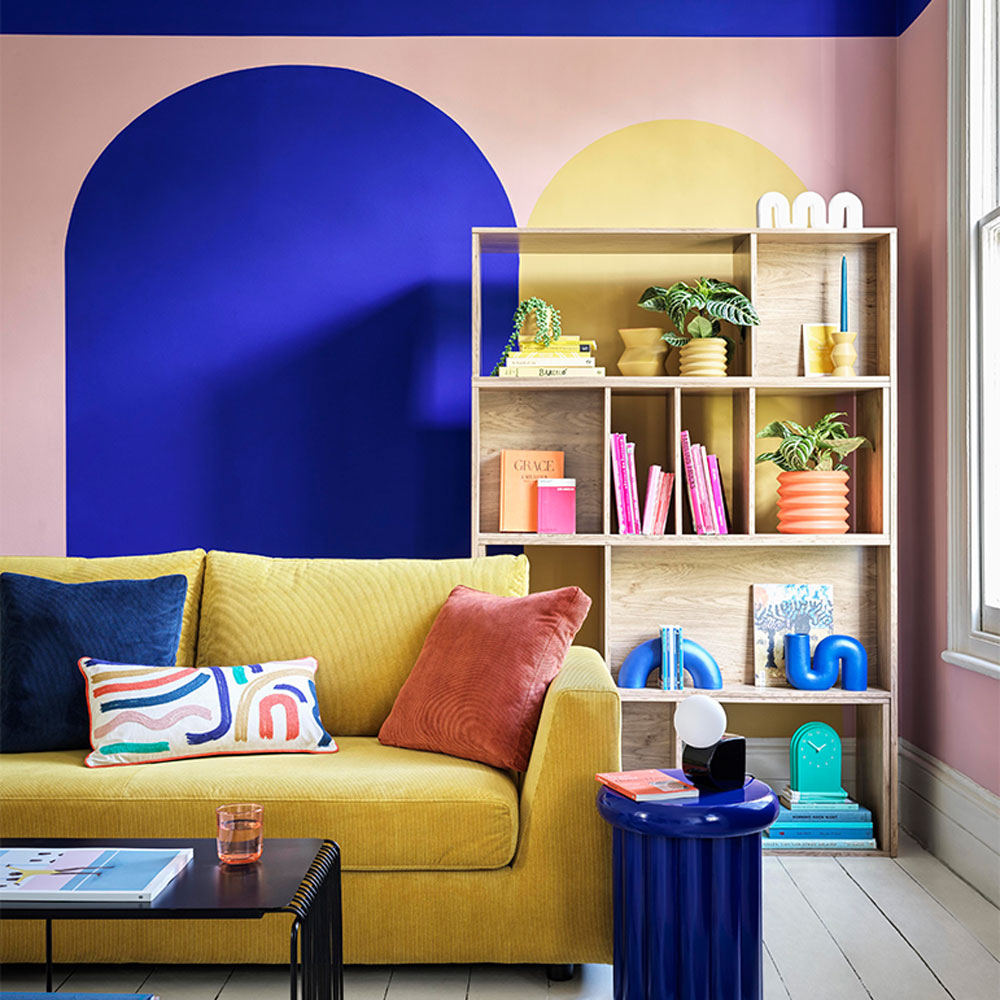
Colour is the ultimate mood lifter, so brighten up an uninspiring living room wall decor idea with a punchy, colour block paint treatment on the walls.
Keep to three key colours, using a softer shade for your background and then introducing bolder accent colours in blocks, such as a sunny yellow or bright electric blue. For a playful look, paint curves and arched sections and then echo these with shapely ceramics, prints and art work on display.
‘Colour plays such an important part in our homes as it allows us to create not only style, but increase our mood, our emotions and our feelings,’ says Andrew Tanner, Design Manager at Habitat. ‘After spending more time indoors than ever before we’ve turned to using uplifting palettes and bold and vibrant hues that evoke the senses, paired with sculptural, playful forms that ultimately make you smile.’
14. Think outside the box with chic cubbies
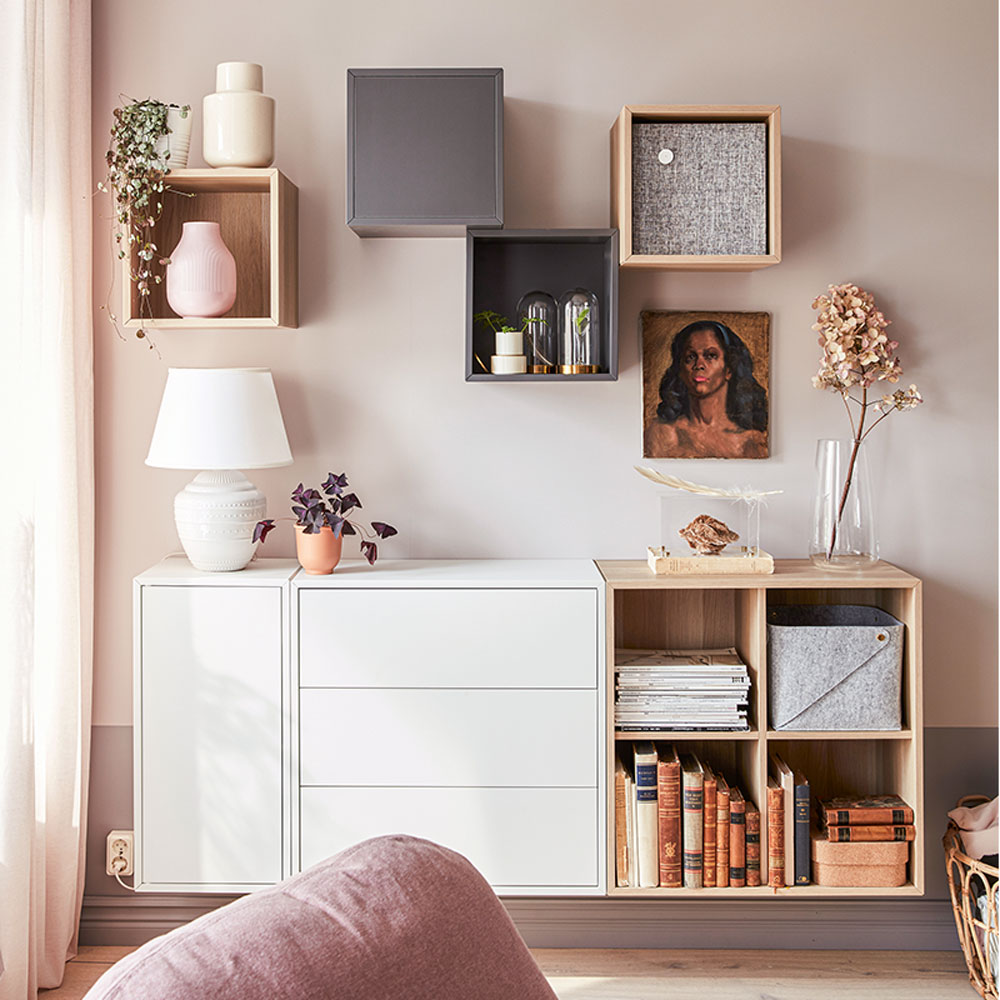
Combine wall decor with storage for a fun and functional living room display. Living rooms can be home for all manner of items, from books and papers to media kit and toys, so hideaway storage is essential.
Opt for a floating wall-hung unit rather than floorstanding furniture - it won’t block the flow of floor space, so the room will feel bigger. Add cubes arranged artfully above, with a combination of closed storage and open cubbies for display.
15. Run shelving wall to wall
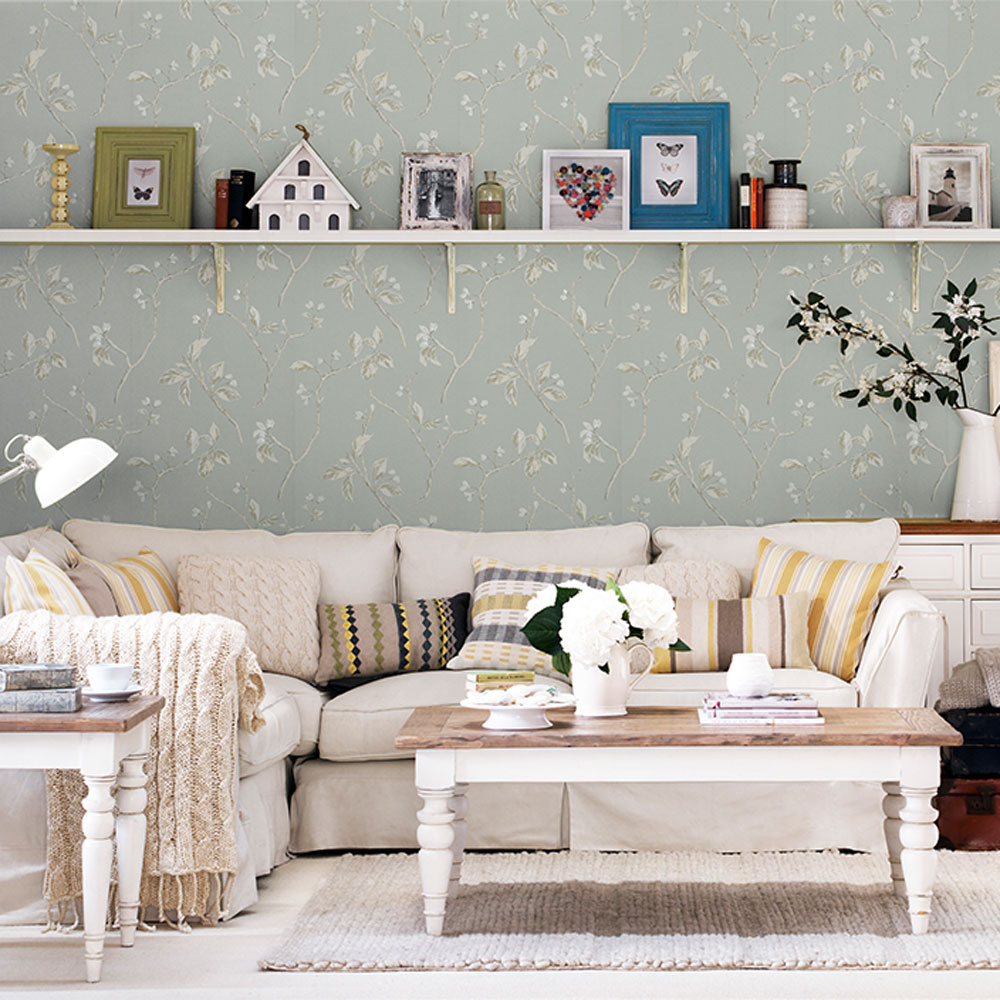
Create a relaxed, eclectic display area with a longline run of open shelving on the wall area above a sofa. Large expanses of wall like this can be difficult to get right, but shelves or picture ledges are easy to put up and the display can be arranged (and rearranged) seasonally or when new pieces are added. A trailing floral or delicate watercolour wallpaper makes a pretty back-drop for a display area.
16. Target clutter hotspots
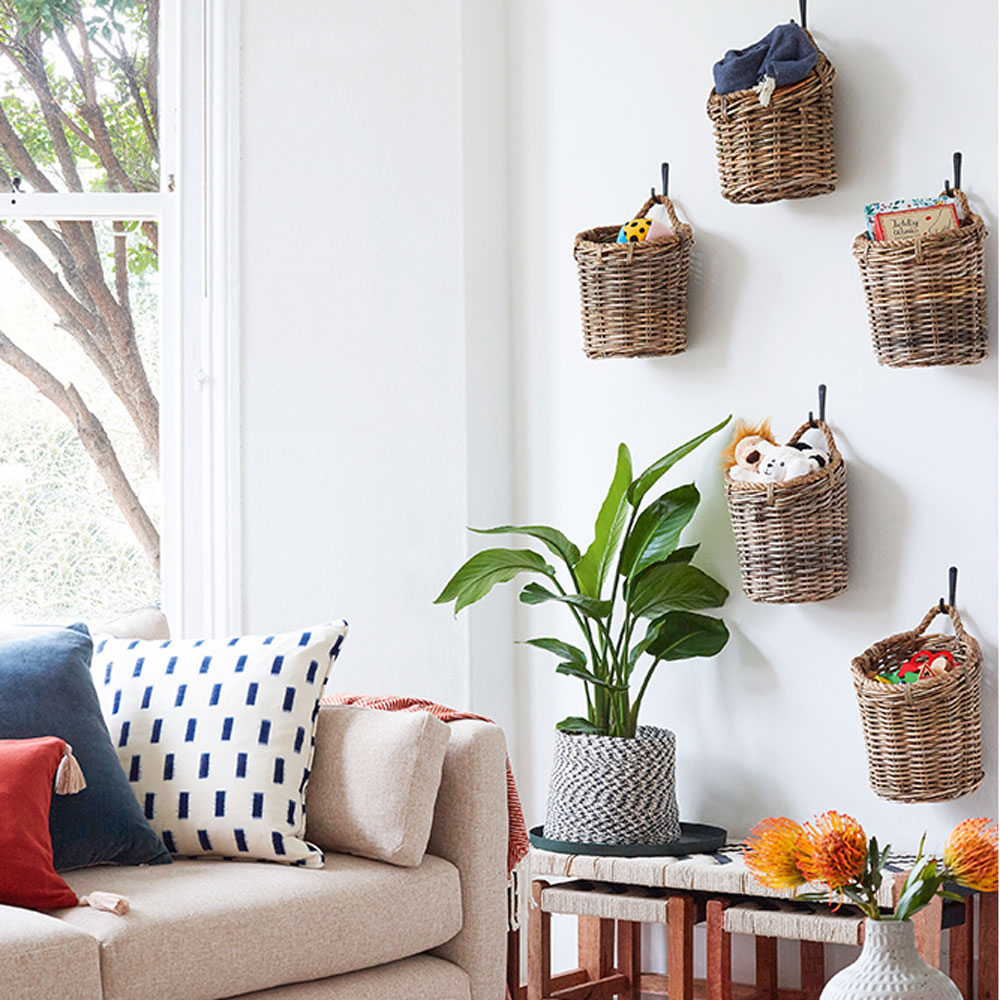
Take a practical approach with living room wall decor in a family room or play space where toys and clutter tends to accumulate. Designated baskets are great for quick end-of-day tidy-ups for toys, books, magazines, iPads and other stuff that tends to lay about.
Go for rustic willow baskets that will tie in with living room decor more stylishly than bright plastic and arrange on the wall with hooks hung at staggered heights. Have a couple up high for adults to reach and some lower down so that little ones can tidy away easily.
17. Make your own wall art
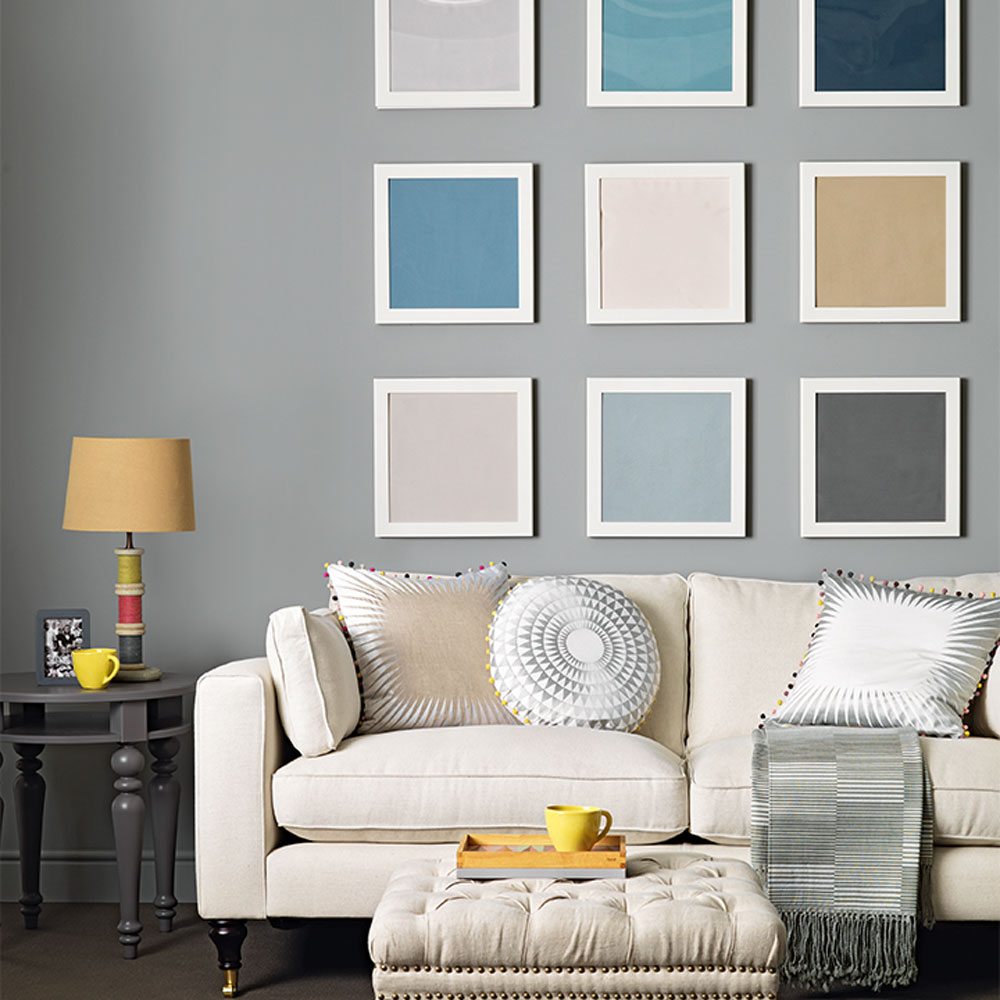
Knowing what to do with the empty wall space above a sofa can be tricky. Hanging wall art is the obvious solution, but a single print can look lost on its own and a mismatched collection can often look messy.
Create a grid arrangement tailored to fit the space perfectly. Aim for an arrangement roughly two thirds the sofa’s length for a balanced look and hang so that there is a gap of around 10-15cm between the bottoms of the lower frames and the top of the sofa.
Use album frames to display fabric, wallpaper or painted card swatches for a colour co-ordinated look. Front-loading frames like these make it super easy to change or rearrange your display
18. Create calm with a lush hanging garden
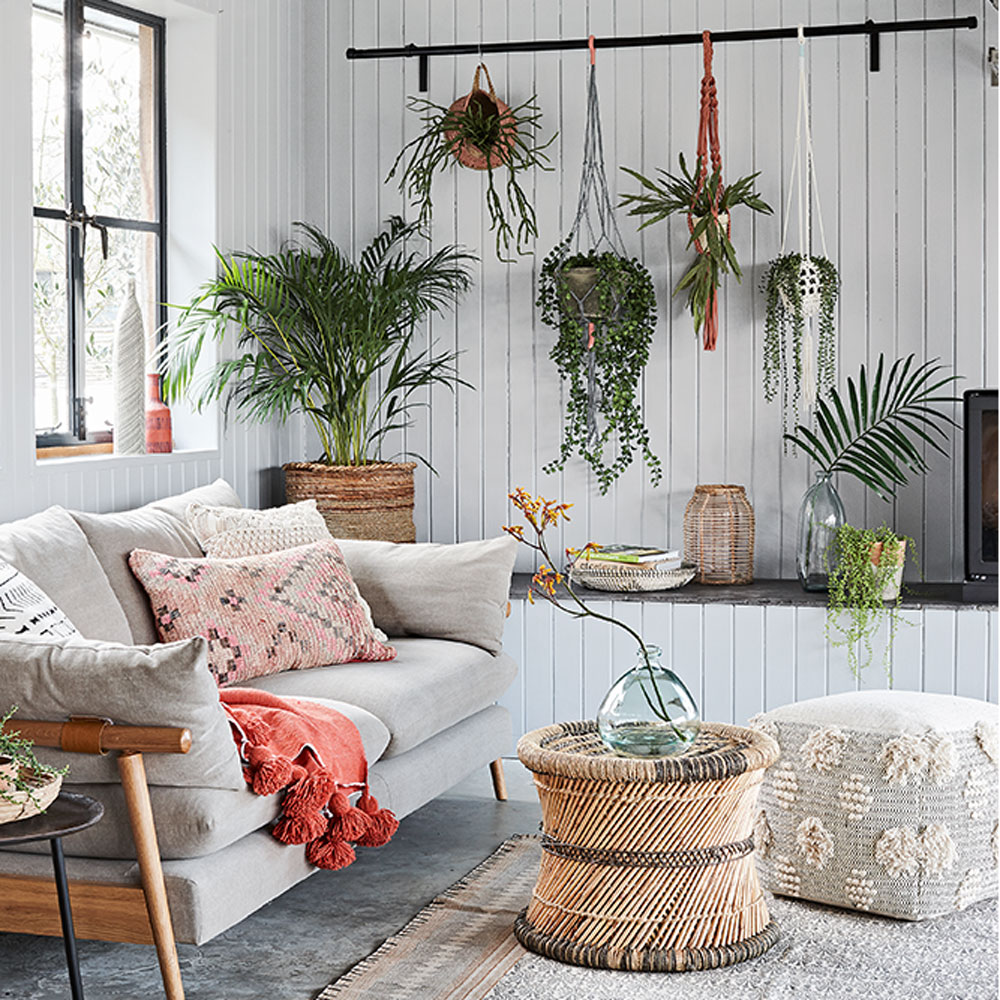
Plants and greenery make a natural choice for wall decor with a living wall display that will just get better and better as time goes on and plants mature.
Combine a hanging arrangement with trailing plants in baskets above a ledge or sideboard lined with tubs and planters so that ample wall space is covered. A simple metal curtain pole fixed to the wall with a row of S-hooks makes the ideal hanging spot with a selection of plants arranged at staggered heights.
19. Put your living room on the map
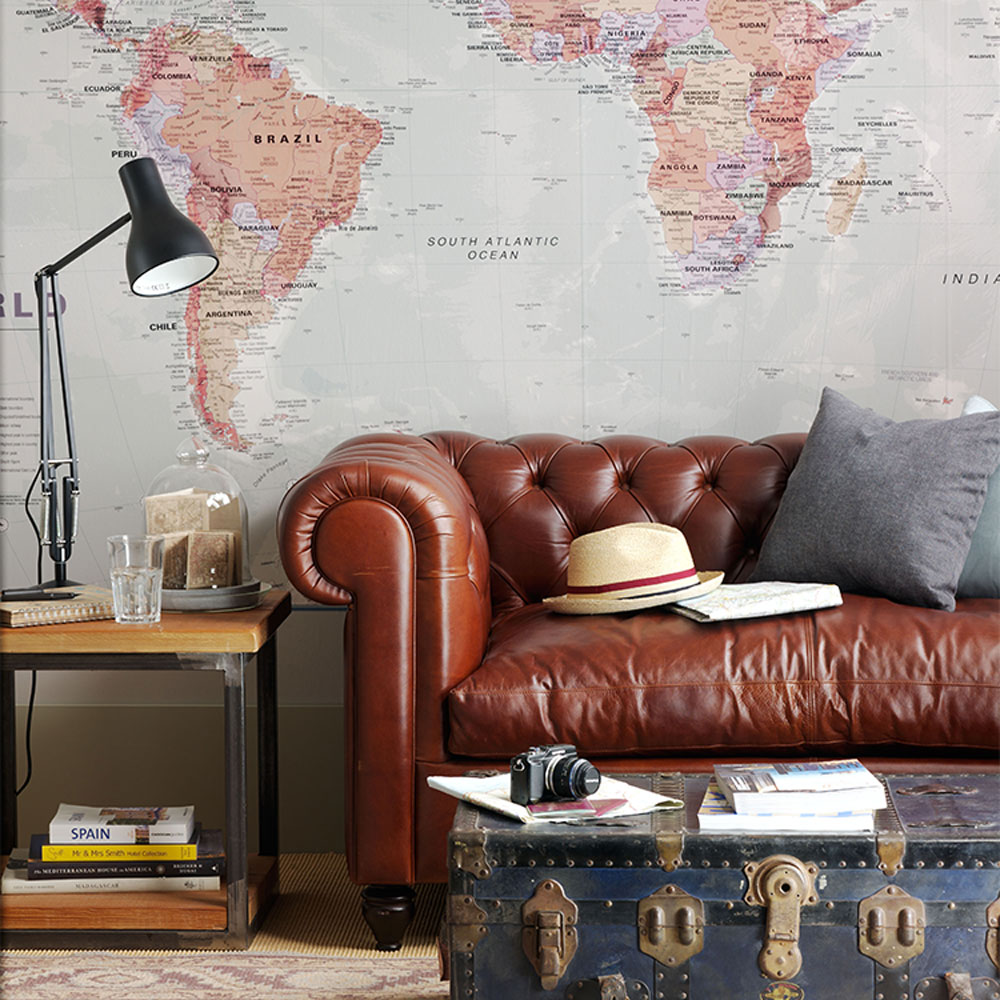
For a look that has bags of personality and creates a fabulous focal point, try covering one wall with a full-sized mural. A sepia-toned map makes a great backdrop for a cosy snug or reading nook teamed with a traditional leather Chesterfield and a traveller-themed trunk for a coffee table.
Whatever design you go for, once your mural is in place, let it be the guide for the rest of the room’s colour scheme. Paint adjoining walls in a toning background colour to give the mural extra impact and keep the rest of the decor fairly restrained so that the room doesn’t feel too kitsch.
20. Showcase a statement wallpaper
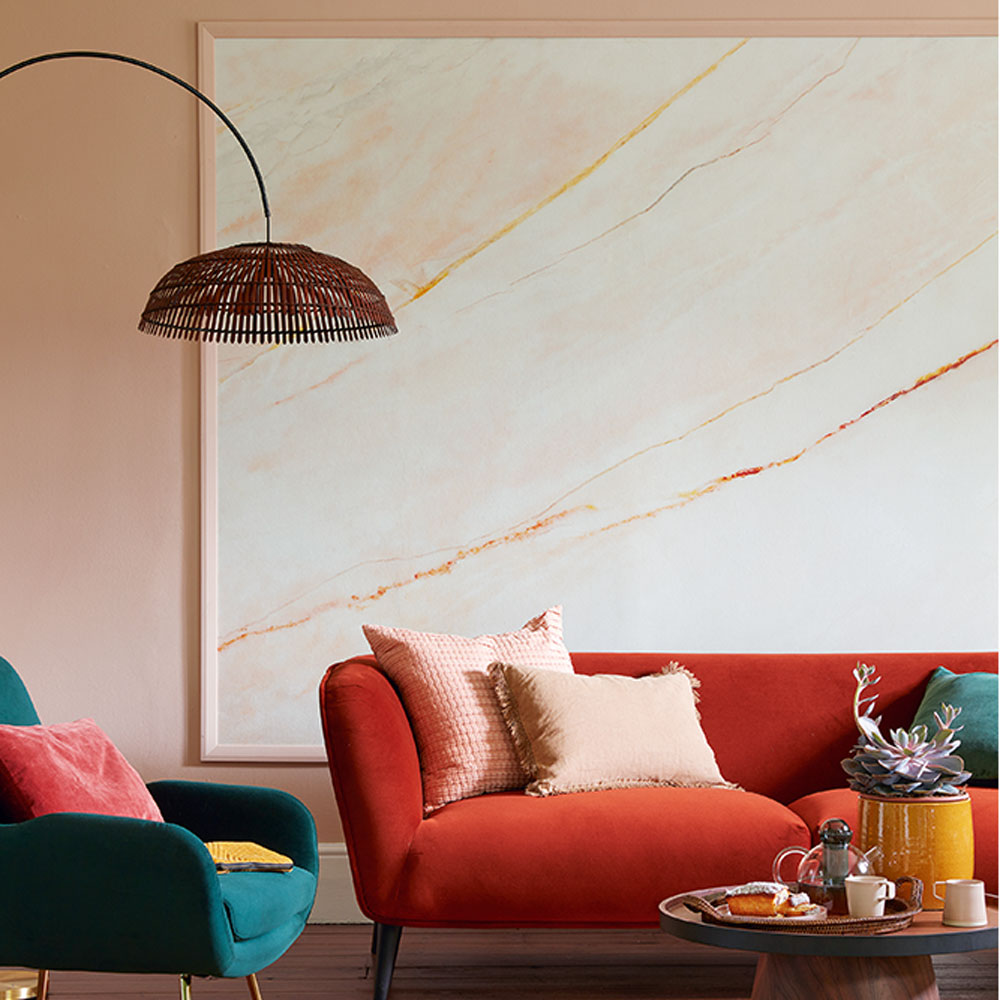
If you’re pattern-shy, try an alternative to traditional living room wallpaper ideas, and go for this simple look that shows off just a hit of pattern rather than all-over pattern wall to wall.
An easy idea to tackle, framing a panel of wallpaper with simple wooden beading creates a striking focal point that has the look of a bespoke piece of art, without the hefty price tag. Try it behind a sofa or sideboard to zone in on or highlight the area. Paint beading to match wall colour for a subtle effect or in a contrast shade to make the panel really pop.
21. Give living room shelves an ombre effect
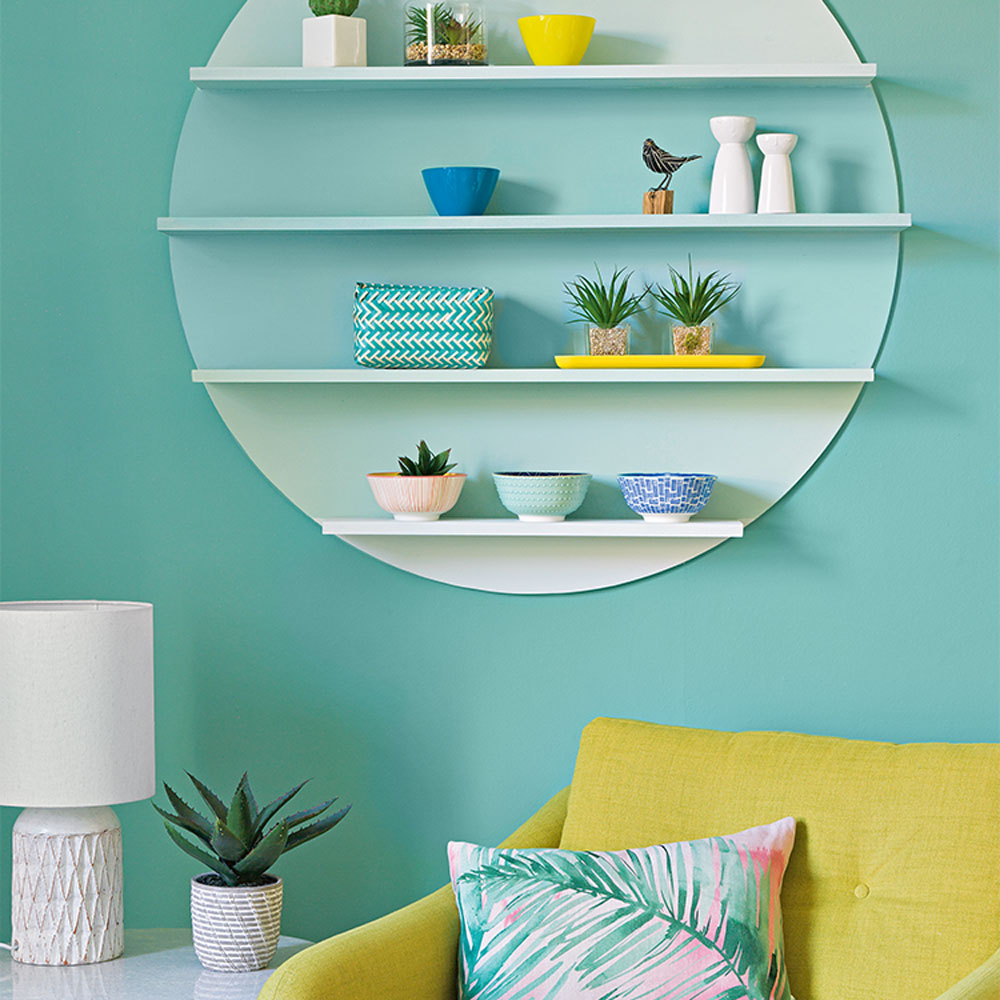
Alcoves and corners often get neglected when it comes to living room wall decor. While a splash of bright paint colour or a panel of wallpaper is an easy option, adding a bespoke piece will take things up a level.
Try a simple shelving idea made using a circle of MDF with a few planks cut to size to create mini shelves - DIY stores will often be able to cut these to size for you. Once assembled, paint your shelf unit white, then once dry, use tester pots in lighter shades than your wall colour to create graduated stripes.
Don’t overload the shelves with books and ornaments. Position a few items here and there to let the ombre-effect colour show through.
22. Create a family gallery
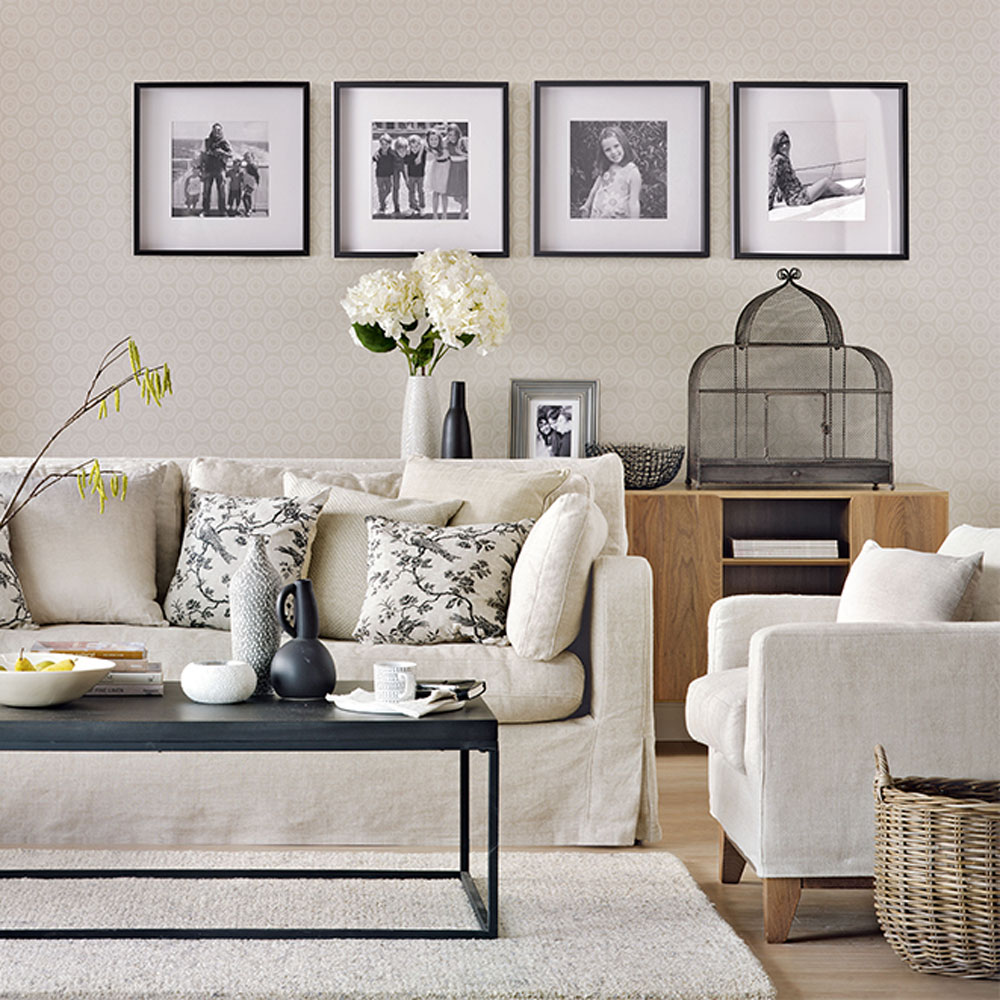
Family photographs are always a winner on display in living rooms, but rather than having a random selection shoved on a shelf, create a more structured arrangement with a framed display of family favourites hung together on the wall.
Matching frames and mounts is a great way of adding uniformity to a display, likewise, using all black and white photographs (or all coloured) will make more impact too. Keep the display tight with frames displayed in rows or a grid formation, making sure that spacing is even throughout for a super-smart look.
23. Take wall panelling up a level
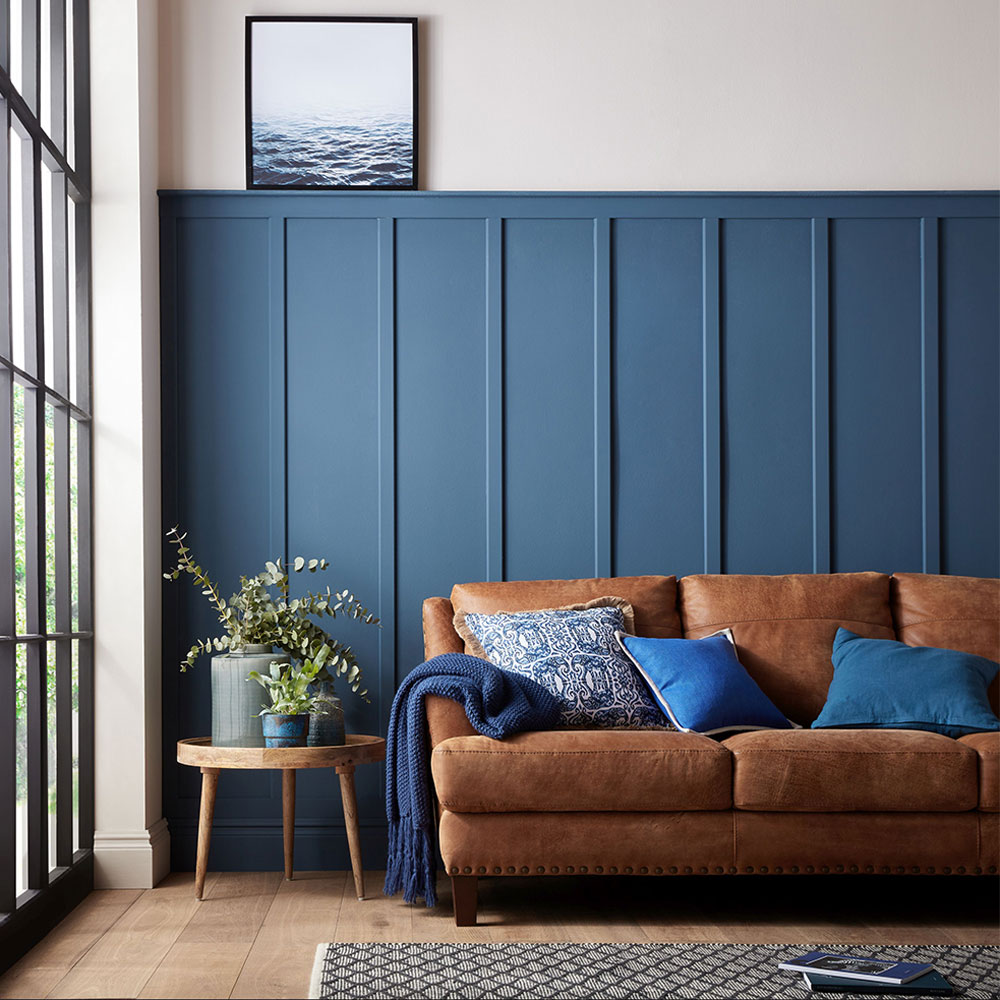
On trend wooden panelling is one of the most searched-for looks on Instagram right now and it’s easy to see why. A great cover-up if your walls are less-than perfect and an easy way of bringing some architectural detail to rooms that are lacking in decorative features.
Smart board and batten panelling like this suits period properties perfectly, adding instant character. Bespoke fully-panelled walls can work out pricey, but it’s easy to create a DIY effect like this using MDF battening and trim, painted one colour to give a fully-panelled effect.
Taking panelling to roughly two-thirds the height of a room creates a relaxed look that’s ideal for living rooms. Paint in a cosy shade and add a shelf trim at the top to give a ledge for displaying pictures and ornaments.
24. Go faux to create a panelled effect
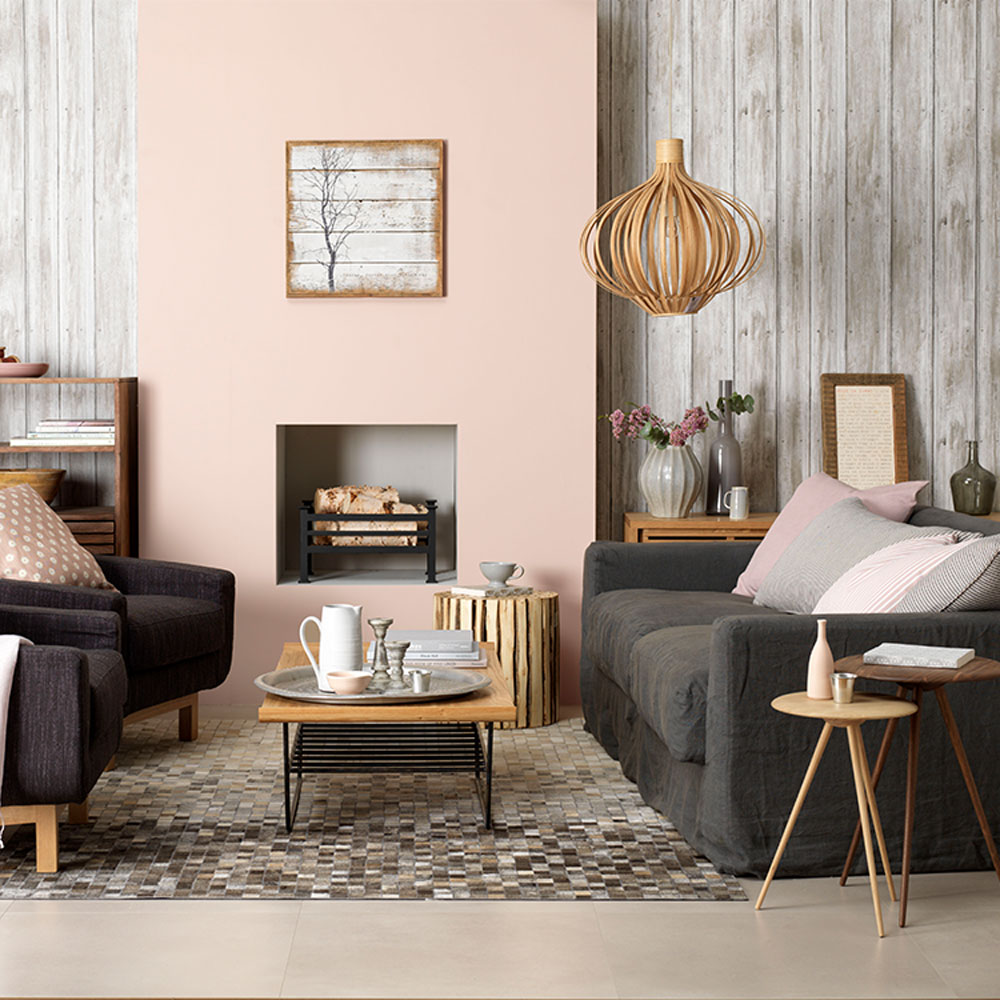
If installing timber panelling yourself is too much of a stretch on your DIY skills, then why not fake it with a ‘wood panel effect’ wallpaper? There are lots of convincing designs out there, from rustic, weathered-look timber wallpapers to traditional period-style painted panelling on a roll.
Create a country cabin vibe with a cosy whitewashed-effect wallpaper that mimics the timber’s natural grain. Rather than taking it wall-to-wall, limit the wallpaper to just the alcove areas either side of a chimney breast, with warm, peachy-pink paintwork to draw attention to the fireplace.
25. Create a colourful focal point
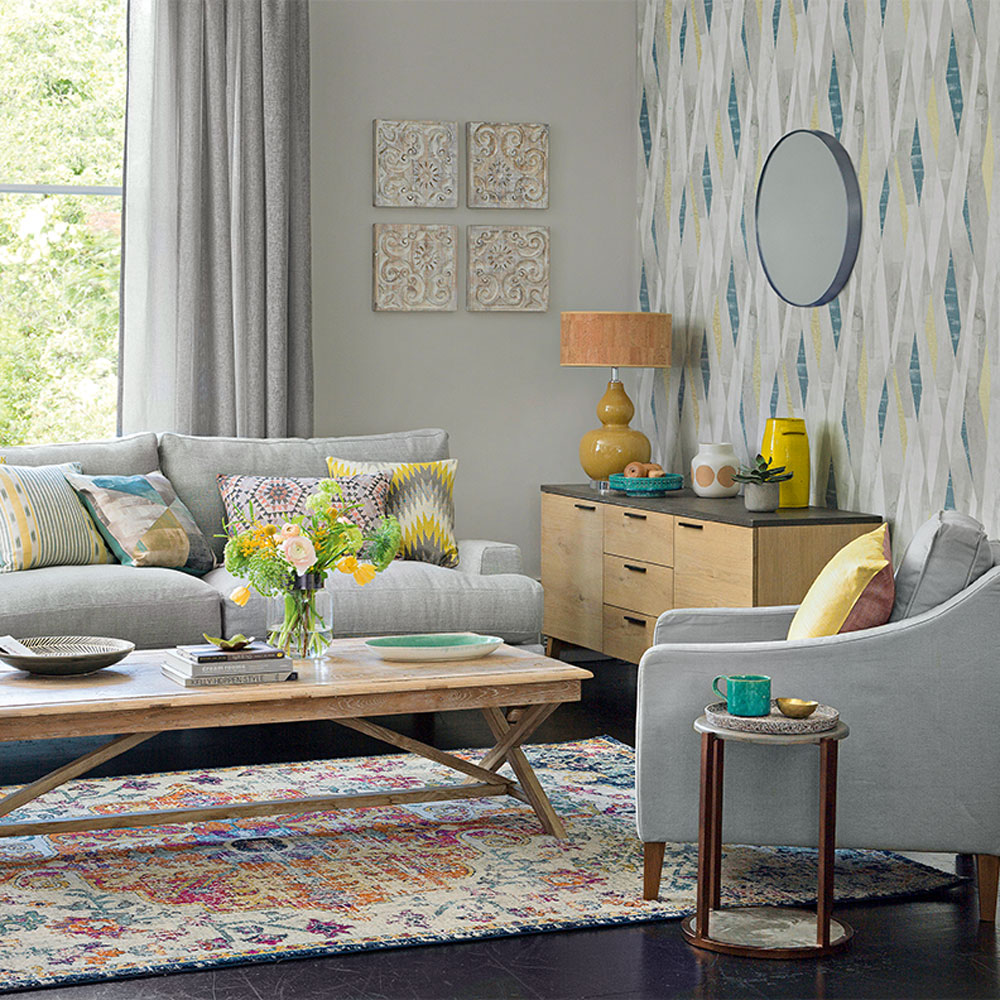
Living room schemes that work best are those that have a focal point, such as a fireplace, window or decorative feature, that your eyes land on when you walk into the room.
In a room that lacks architectural features, introducing a bold wallpaper at one end will help add focus. Avoid oversized patterns that could overpower the room or too-small prints that could look fussy. Instead, choose a mid-sized motif that will add the right amount of detail in soft, muted colours that tie in with the rest of the room’s colour palette.
26. Draw attention to a fireplace
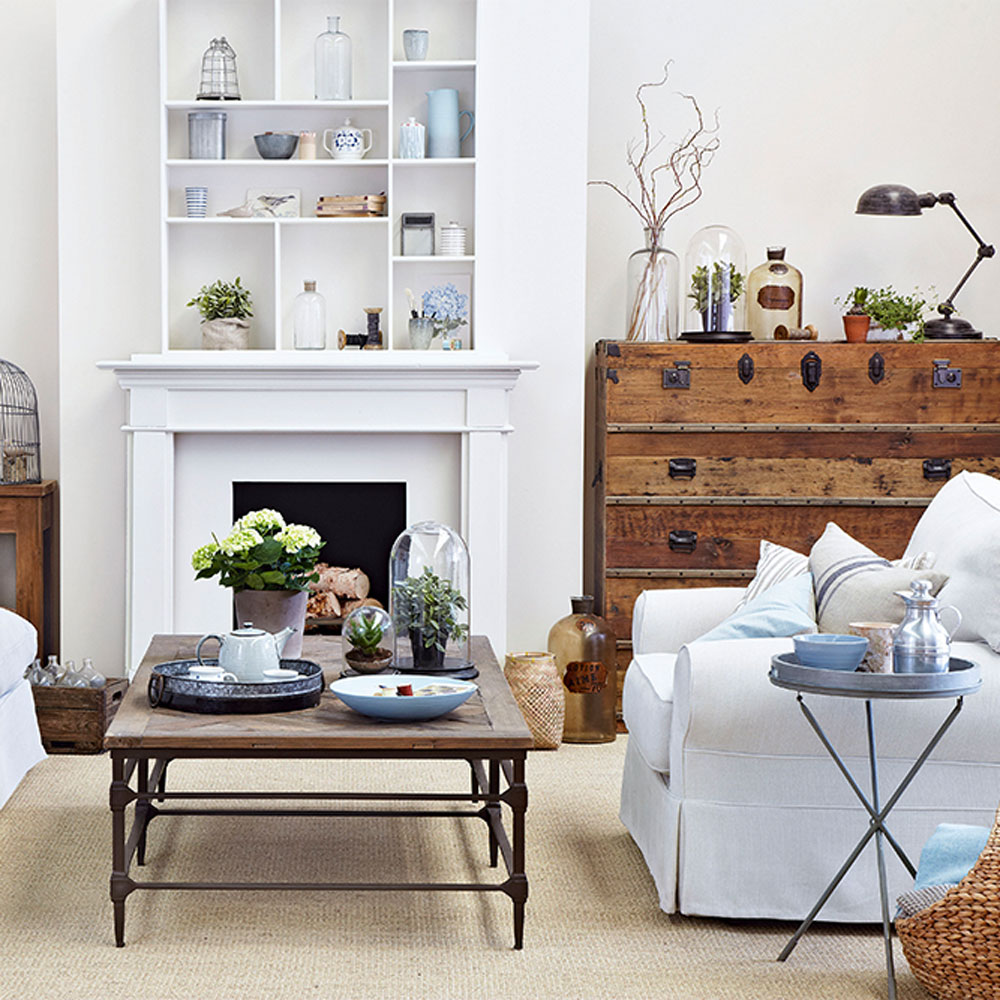
Often chimney breast walls tend to be painted or wallpapered with perhaps a mantel mirror or wall art to create a focal point. Cubbyhole shelving is a quirky alternative positioned on the wall above a mantel and creates a lovely area to display favourite objects and treasured finds.
Paint shelving to match wall colour for an understated look or add a pop of colour by painting inside individual cubbies, using contrast colours to make display items really stand out.
27. Try an eclectic mix using vintage picture frames
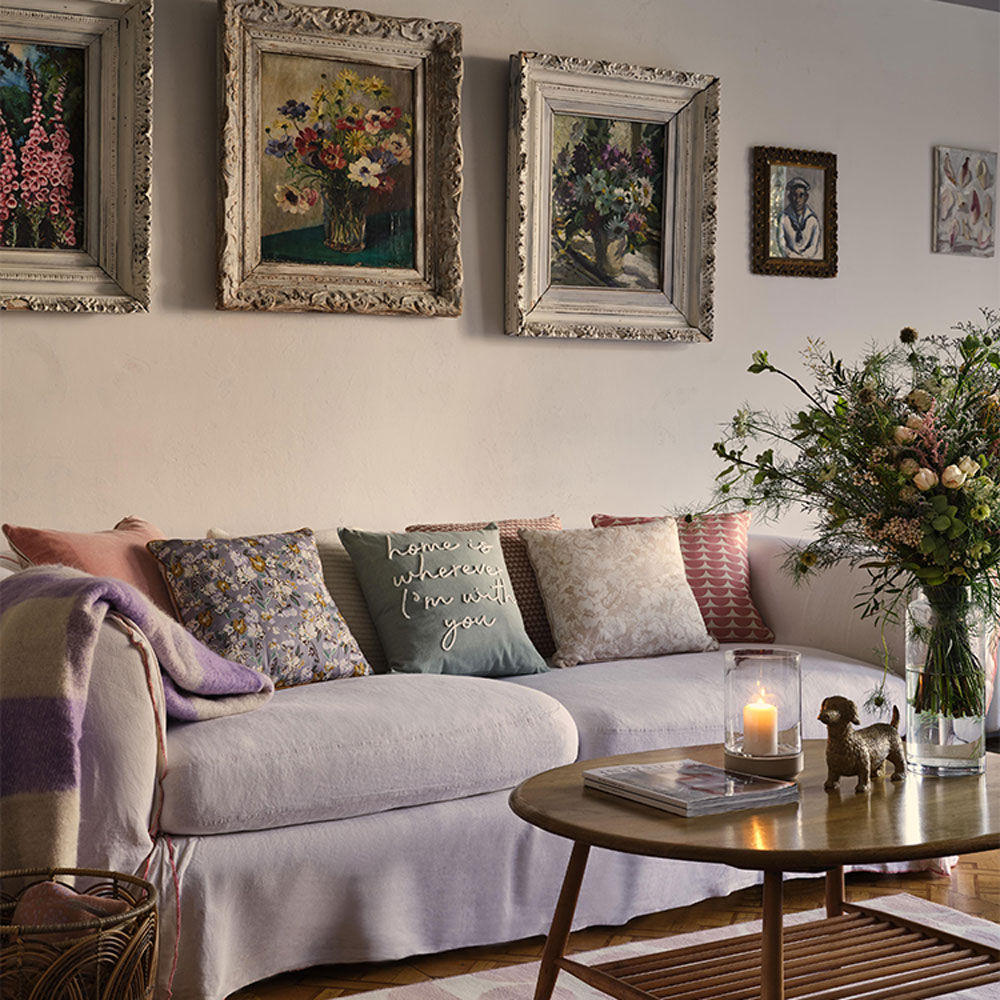
Artwork is always a winner when it comes to filling wall space. If structured grids and galleries aren’t for you, create a more informal look with a mix of painted watercolours or oil-painted pieces displayed in vintage picture frames.
Pick pictures that complement each other, such as a similar style or colour palette, and try painting the wall behind in a shade that complements the picture frames so that it will bring out the colour of the art.
What are good living room over the sofa wall decor ideas?
The wall area above a sofa is often quite vast, so it can be a tricky area to get right. Wall art is the obvious choice, but getting picture size and placement right is key to a successful scheme. Pictures that are too small can look lost hanging above a large sofa, and likewise a picture that is too large can overwhelm a sofa instead of enhancing it.
A rule of thumb is that a single picture (or group of pictures) shouldn’t be wider than the actual sofa itself. Aim for something that measures roughly two thirds the length of the sofa - this could be one large picture or an arrangement of several smaller pictures.
Picture height is key too. In a living room, where you are more likely to be sitting down, hang artwork low enough so you can enjoy it while seated, with the centre of your image positioned roughly at eye level.
Does every wall need decor?
Not necessarily. It can be easy to get carried away and try to fill every wall with decor, but if there’s too much going on in one room it can feel a little overpowering. Creating balance is key to any successful decorating scheme. So if you have one area that’s quite busy visually, counteract this by having areas that feel calmer and have less going on.
Some walls will already have architectural elements, such as windows, doors, chimney breasts and alcoves, so these walls may not need much else added. Large empty walls are the key areas to focus on first. Think about furniture placement before you add any kind of decoration. Furniture can be a great space-filler, so decide where key items such as sofas, sideboards and shelving units are going to be positioned before you start decorating.

Lisa is Deputy Editor of Style at Home magazine and regularly contributes to sister title Ideal Home. She has written about interiors for more than 25 years and about pretty much every area of the home, from shopping and decorating, crafts and DIY to real home transformations and kitchen and bathroom makeovers. Homes and interiors have always been a passion and she never tires of nosying around gorgeous homes, whether on TV, online, in print or in person.
-
 Should your front door colour match your hallway? Interior experts reveal 3 reasons why it should (and 3 reasons it shouldn't)
Should your front door colour match your hallway? Interior experts reveal 3 reasons why it should (and 3 reasons it shouldn't)Are you team matching or contrasting?
By Ellis Cochrane
-
 This £200 limited-time discount makes this Dyson vacuum cheaper than I’ve ever seen it - run don’t walk to Argos for this bargain
This £200 limited-time discount makes this Dyson vacuum cheaper than I’ve ever seen it - run don’t walk to Argos for this bargainIt's the most affordable Dyson on the market right now
By Lauren Bradbury
-
 Martin and Shirlie Kemp’s pastel flower beds has given their Victorian renovation a romantic look - how you can get the look
Martin and Shirlie Kemp’s pastel flower beds has given their Victorian renovation a romantic look - how you can get the lookTheir pastel garden is the cottage garden inspo you've been looking for
By Kezia Reynolds